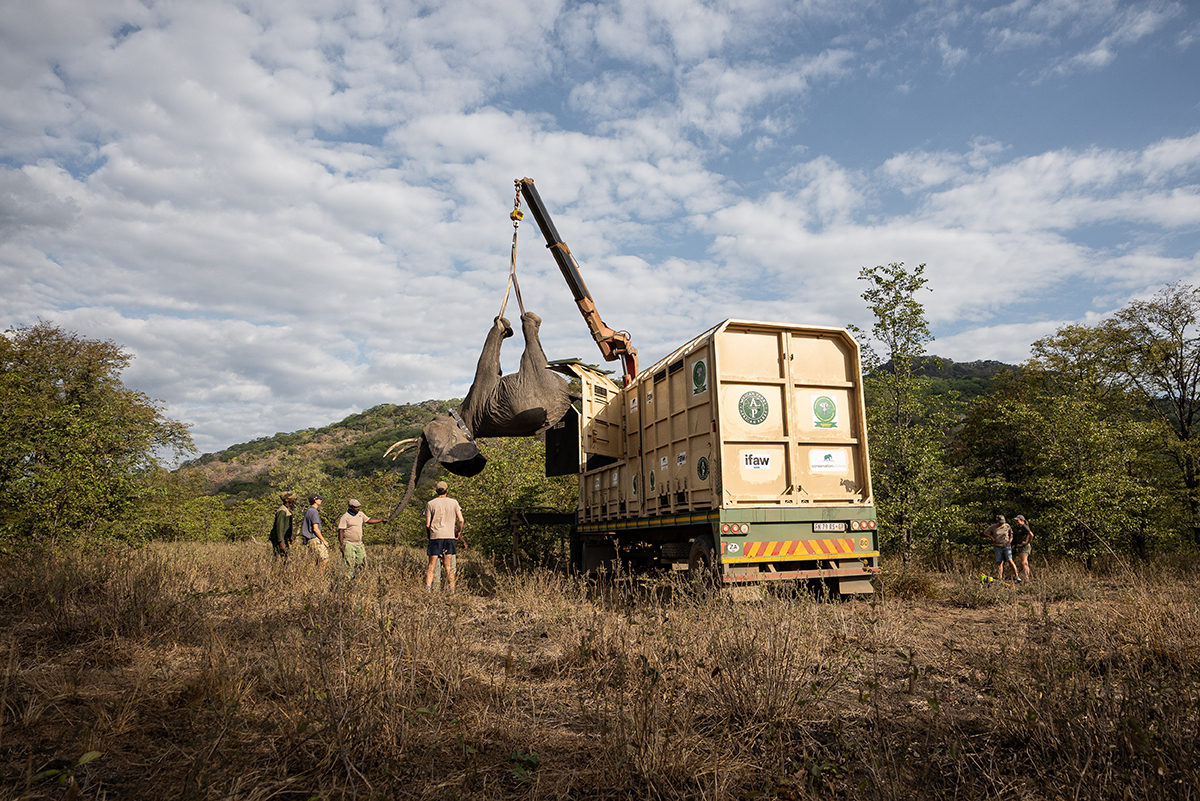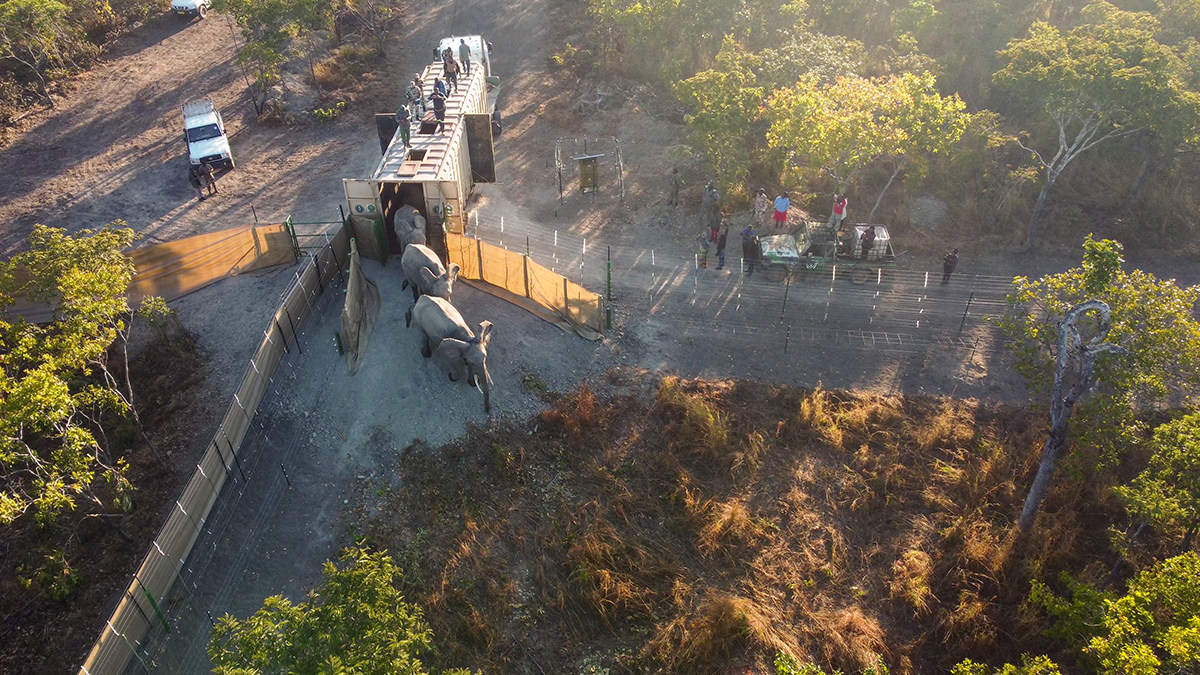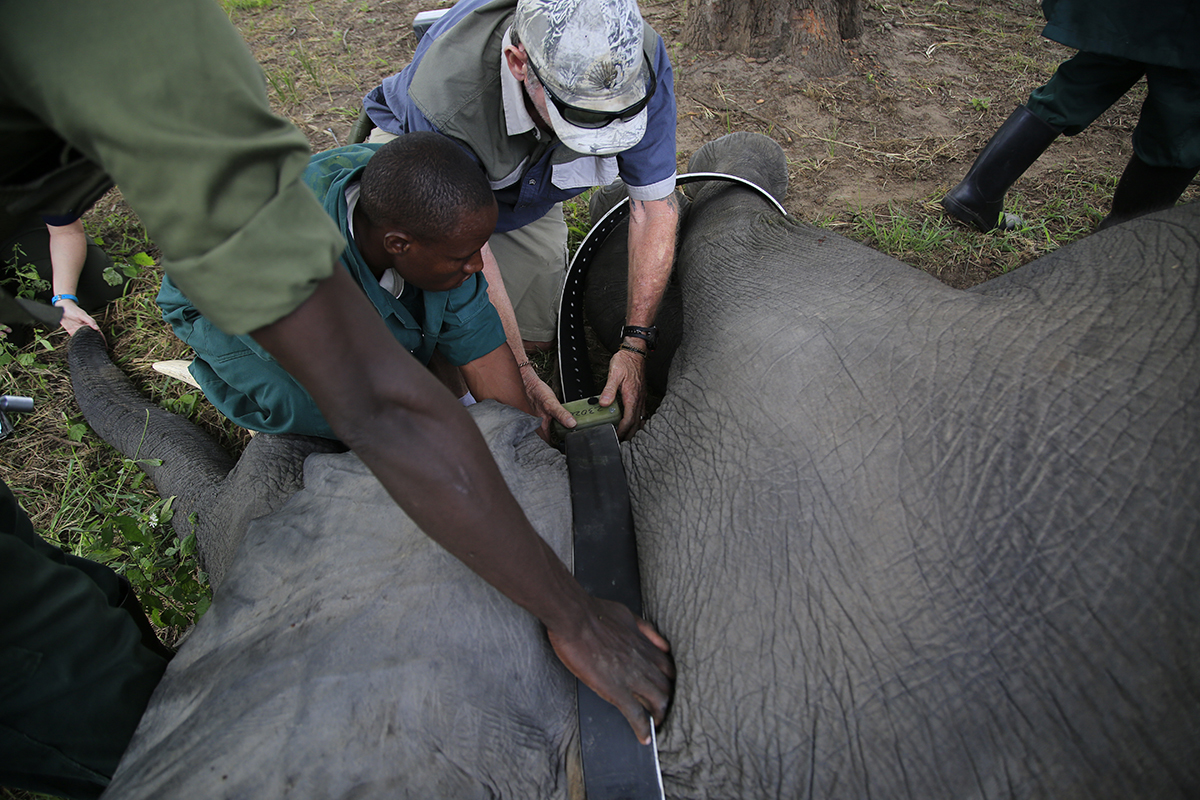How do you move an elephant?
How do you move an elephant?

Wildlife conservation sometimes involves the capture and relocation (or “translocation”) of animals. Experts translocate wildlife for many reasons: to reduce human-wildlife conflict, for wildlife reintroduction, or to rehabilitate a conservation area. In the case of elephants, the monumental task of translocation requires weeks of planning, incredible teamwork—and heavy machinery.
The process of relocating elephants often sparks the curiosity of elephant enthusiasts. Here, we answer your biggest questions about how we transport elephants!
How are elephants transported?
When a team of experts translocates elephants they first sedate them, carefully secure straps to their legs, and hoist them upside-down into a closed “wake-up” crate. A veterinary specialist administers an antidote, which revives the elephants. Once awake, they move from the wake-up crate through a panel that slides open to a specially designed transport trailer for the journey.
Why are elephants transported upside down?
Lifting tranquilised elephants upside down by their legs is actually the most effective, common and safe way of moving them into a trailer. Unlike a person, an elephant’s lungs are directly attached to the walls of their chest cavity and diaphragm—meaning they need their torso unrestricted in order to inhale. By hoisting them upside down, the teams ensure the elephants can breathe normally during transport.
In July 2022, 263 elephants have been moved to Kasungu National Park in Malawi as part of a national conservation initiative to maintain healthy habitats in Malawi’s national parks, establish viable elephant populations, and ensure the prosperity of local communities living around the parks.
Can elephants be transported by plane?
Rescue organisations sometimes transport young elephants by plane from their rescue location to rehabilitation facilities. However, it is unusual for adult wild elephants to be transported by plane, simply because of their size and behavior. Adult male elephants can be over 13 feet tall and weigh up to seven tons, while adult females can weigh nearly four tons. Because adult elephants need to be moved in family groups, transport by plane is not feasible.
Instead, we capture and transport elephants in specially designed, closed metal crates that are big enough to accommodate an adult bull or a small family herd. Large trucks then move these crates to the elephants’ new home.
Why do we move elephants?
When elephant populations increase near densely populated areas, humans and wildlife can come in conflict for space and resources. Elephants sometimes raid crops in agricultural fields or destroy granaries or stores of food, endangering human livelihoods—and lives. At the same time, elephants are keystone species that play critical roles in their environments. By moving elephants to more remote protected areas, we can help local communities, while bolstering an elephant population in a more remote conservation area.
How do we choose which elephants to move?
Choosing which elephants to move can depend on the goals of each translocation. Often, we move elephants from areas where elephant populations are stable or increasing in close proximity to humans to reduce human-wildlife conflict.
When choosing specific elephants to move, teams capture entire elephant family groups. Elephants are incredibly social, and moving an entire family results in greater success of the translocation, and less stress for the individual elephants—ensuring their overall emotional and physical well-being.
Adult bull elephants are mostly solitary or found in small “bachelor” herds. We transport bulls individually because of their size and weight. Mature bulls play an important role in disciplining and teaching younger bulls.
Do we tranquilise the elephants before we transport them?
Yes, since we translocate wild elephants, we must sedate them to safely hoist them onto a vehicle.
What happens before we move elephants?
Before any relocation, teams undertake a considerable amount of prep work: everything from mapping the translocation route and obtaining permission from authorities, to constructing a temporary holding enclosure, or “boma”, at the release site.
On the day of the move, we quickly dart entire family herds to sedate them. A skilled team of veterinary support staff performs health checks, while researchers record data about the captured elephants. Oftentimes, we put a tracking collar on the matriarch of the herd, which will help us track the herd in their new home. One at a time, staff members attach straps to the elephant’s legs, do a last health check, and lift the elephant into a waiting trailer with a crane. From capture to trailer, the whole process is over in about 20 minutes.

How much does an elephant weigh? Does lifting an elephant by their legs hurt their legs or neck?
Elephants are Earth’s largest land mammals, making transport challenging. Adult African elephants can weigh between 5,000 to 15,000 pounds. Lifting elephants by the legs does not hurt them, and lifting them and gently laying them down inside the crate takes just a few minutes, after which they are quickly administered an antidote and awaken.
Is upside-down transport scary and/or painful for the elephants? Do elephants remember everything that happens?
The elephants are tranquilised during capture and while they are lifted into a trailer. They are entirely unaware and fall into a deep sleep. Once a whole family group is safely in a trailer, the veterinary team administers a drug that reverses the sedative, and the elephants wake up. Translocation is a stressful time, which is why we move them as a group. We make every effort to minimise their stress. As with most species, short-term stress has little long-term effect on them.
How far do we transport the elephants?
The elephants are only in the air for a few minutes while the team moves them to a waiting trailer. After that, they are transported in a trailer by vehicle, often hundreds of miles from their original location. The elephant capture team monitors the health and welfare of the elephants throughout their journey, which takes no longer than 12-14 hours.

What happens when the elephants arrive at their new home?
On arrival at their destination, we release the elephants directly into a holding enclosure, or “boma”, where they have a chance to settle down, drink water and get used to their new surroundings. Wildlife rangers remain throughout this time to keep a check on their welfare. Once they have settled, the team opens the boma and the elephants are free to walk into their new wild home.
How do the elephants find food and water in their new habitat?
Elephants have an incredible sense of smell—in fact, they can even sense water underground! Their keen sense of smell helps them find water even in dry seasons, and in new places.
Do we tag the elephants to track them after we release them?
Yes, we fit elephants with satellite collars to track them remotely. We collar adult male and matriarch females within family groups, so that scientists can monitor their movements. The batteries on the collars last for about four years. Only adult elephants are collared and not growing youngsters, as they will quickly out-grow collars.

Why do the released elephants have to wear a tracking collar?
Tracking collars are one of the most effective ways to track individual animals after release. The collars are designed to be minimally invasive to the animal, allowing them to go about their daily business as usual. Tracking collars and satellite tags collect crucial data: information like where they are located, how fast they are traveling, and how they are faring after release.
Will the elephants try to move back to their old home?
We move elephants a sufficient distance from their old homes so that they should not try to return to their original location. Elephants will however wander in their new location as they try to get their bearings.
Will the elephants be protected at their new location?
Moving hundreds of elephants is a jumbo-sized task. Countless hours of planning go into the process: choosing elephants to move, arranging safe transport, and ensuring success after their release. We work with other non-profits and local governments to provide the best protection possible for animals after translocation. Oftentimes, this means moving them to an established conservation area or national park with protections and anti-poaching rangers in place.
Related content
Our work can’t get done without you. Please give what you can to help animals thrive.